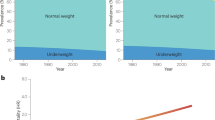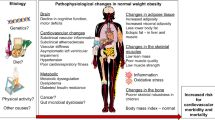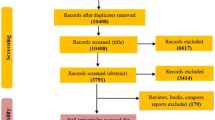Abstract
Background and objectives:
The pathogenesis of the metabolic syndrome (MetS) is not well understood. This review is based on the hypothesis that both traditional and emerging risk factors act through adiponectin.
Subjects and methods:
We conducted a search of the literature using prominent electronic databases and search terms that included in combination: adiponectin, diet, dietary patterns, exercise, metabolic rate, MetS and testosterone. Articles were restricted to studies conducted on adult humans, reported in English and within the time period 2000–2012.
Results and conclusions:
Both traditional and emerging risk factors associated with the MetS show some evidence of exerting their influence through adiponectin. High-quality randomized controlled trials that alter adiponectin levels are required to further corroborate this hypothesis.
This is a preview of subscription content, access via your institution
Access options
Subscribe to this journal
Receive 12 print issues and online access
$259.00 per year
only $21.58 per issue
Buy this article
- Purchase on Springer Link
- Instant access to full article PDF
Prices may be subject to local taxes which are calculated during checkout

Similar content being viewed by others
References
Corona G, Monami M, Rastrellia G, Aversa A, Tishova Y, Saad F et al. Testosterone and metabolic syndrome: a meta-analysis study. J Sex Med 2011; 8: 272–283.
Ryo M, Nakamura T, Kihara S, Kumada M, Shibazaki S, Takahashi M et al. Adiponectin as a biomarker of the metabolic syndrome. Circ J 2004; 68: 975–981.
Beavers KM, Nicklas BJ . Effects of lifestyle interventions on inflammatory markers in the metabolic syndrome. Front Biosci 2011; 3: 168–177.
Garg MK, Dutta MK, Mahalle N . Adipokines (adiponectin and plasminogen activator inhhibitor-1) in metabolic syndrome. Indian J Endocr Metab 2012; 16: 116–123.
Xydakis AM, Case CC, Jones PH, Hoogeveen RC, Liu M, O’Brian Smith E et al. Adiponectin, inflammation, and the expression of the metabolic syndrome in obese individuals: the impact of rapid weight loss through caloric restriction. J Clin Endocrinol Metab 2004; 89: 2697–2703.
Eckel RH, Grundy SM, Zimmet PZ . The metabolic syndrome. Lancet 2005; 365: 1415–1428.
Chandran M, Phillips SA, Ciaraldi T, Henry RR . Adiponectin: more than just another fat cell hormone? Diabetes Care 2003; 26: 2442–2450.
Whitehead JP, Richards AA, Hickman IJ, Macdonald GA, Prins JB . Adiponectin—a key adipokine in the metabolic syndrome. Diabetes Obes Metab 2006; 8: 264–280.
Lara-Castro C, Fu Y, Chung BH, Garvey WT . Adiponectin and the metabolic syndrome: mechanisms mediating risk for metabolic and cardiovascular disease. Curr Opin Lipidol 2007; 18: 263–270.
Nakashima R, Yamane K, Kamei N, Nakanishi S, Kohno N . Low serum levels of total and high-molecular-weight adiponectin predict the development of metabolic syndrome in Japanese–Americans. J Endocrinol Invest 2011; 34: 615–619.
Yamauchi T, Kamon J, Waki H, Terauchi Y, Kubota N, Hara k et al. The fat-derived hormone adiponectin reverses insulin resistance associated with both lipoatrophy and obesity. Nat Med 2001; 7: 941–946.
Kissebah AH, Sonnenberg GE, Myklebust J, Goldstein M, Broman K, James RG et al. Quantitative trait loci on chromosomes 3 and 17 influence phenotypes of the metabolic syndrome. Proc Natl Acad Sci USA 2000; 97: 14478–14483.
Kajikawa Y, Ikeda M, Takemoto S, Tomoda J, Ohmaru N, Kusachi S . Association of circulating levels of leptin and adiponectin with metabolic syndrome and coronary heart disease in patients with various coronary risk factors. Int Heart J 2011; 52: 17–22.
Hamilton MP, Gore MO, Ayers CR, Xinyu W, McGuire DK, Scherer PE . Adiponectin and cardiovascular risk profile in patients with type 2 diabetes mellitus: parameters associated with adiponectin complex distribution. Diab Vasc Dis Res 2011; 8: 190–194.
Forsythe LK, Wallace JM, Livingstone MB . Obesity and inflammation: the effects of weight loss. Nutr Res Rev 2008; 21: 117–133.
Cornier MA, Dabelea D, Hernandez TL, Lindstrom RC, Steig AJ, Stob NR et al. The metabolic syndrome. Endocr Rev 2008; 29: 777–822.
Xu H, Barnes GT, Yang Q, Tan G, Yang D, Chou CJ et al. Chronic inflammation in fat plays a crucial role in the development of obesity-related insulin resistance. J Clin Invest 2003; 112: 1821–1830.
Sharma P . Inflammation and the metabolic syndrome. Ind J Clin Biochem 2011; 26: 317–318.
Cnop M, Havel PJ, Utzschneider KM, Carr DB, Sinha MK, Boyko EJ et al. Relationship of adiponectin to body fat distribution, insulin sensitivity and plasma lipoproteins: evidence for independent roles of age and gender. Diabetologia 2003; 46: 459–469.
Hulthe J, Hulten LM, Fagerberg B . Low adipocyte-derived plasma protein adiponectin concentrations are associated with the metabolic syndrome and small dense low-density lipoprotein particles: atherosclerosis and insulin resistance study. Metabolism 2003; 52: 1612–1614.
Ruige JB, Ballaux DB, Funahashi T, Mertens IL, Matsuzawa Y, Van Gaal LF . Resting metabolic rate is an important predictor of serum adiponectin concentrations: potential implications for obesity-related disorders. Am J Clin Nutr 2005; 82: 21–25.
Weyer C, Funahashi T, Tanaka S, Hotta K, Matsuzawa Y, Pratley RE et al. Hypoadiponectinemia in obesity and type 2 diabetes: close association with insulin resistance and hyperinsulinemia. J Clin Endocrinol Metab 2001; 86: 1930–1935.
Baratta R, Amato S, Degano C, Farina MG, Patanè G, Vigneri R et al. Adiponectin relationship with lipid metabolism is independent of body fat mass: evidence from both cross-sectional and intervention studies. J Clin Endocrinol Metab 2004; 89: 2665–2671.
Hotta K, Funahashi T, Arita Y, Takahashi M, Matsuda M, Okamoto Y et al. Plasma concentrations of a novel, adipose-specific protein, adiponectin, in type 2 diabetic patients. Arterioscler Thromb Vasc Biol 2000; 20: 1595–1599.
Yang WS, Lee WJ, Funahashi T, Tanaka S, Matsuzawa Y, Chao CL et al. Weight reduction increases plasma levels of an adipose-derived anti-inflammatory protein, adiponectin. J Clin Endocrin Metab 2001; 86: 3815–3819.
Koh KK, Han SH, Quon MJ . Inflammatory markers and the metabolic syndrome: insights from therapeutic interventions. J Am Coll Cardiol 2005; 46: 1978–1985.
Kern PA, Di Gregorio GB, Lu T, Rassouli N, Ranganathan G . Adiponectin expression from human adipose tissue: relation to obesity, insulin resistance, and tumour necrosis factor-a expression. Diabetes 2003; 52: 1779–1785.
Tschritter O, Fritsche A, Thamer C, Michael H, Shirkavand F, Fatemeh S et al. Plasma adiponectin concentrations predict insulin sensitivity of both glucose and lipid metabolism. Diabetes 2005; 52: 239–243.
Yu JG, Javorschi S, Hevener AL, Kruszynska YT, Norman RA, Sinha M et al. The effect of thiazolidinediones on plasma adiponectin levels in normal, obese, and type 2 diabetic subjects. Diabetes 2002; 51: 2968–2974.
Koh KK, Han SH, Quon MJ, Yeal Ahn J, Shin EK . Beneficial effects of fenofibrate to improve endothelial dysfunction and raise adiponectin levels in patients with primary hypertriglyceridemia. Diabetes Care 2005; 28: 1419–1424.
Furuhashi M, Ura N, Higashiura K, Murakami H, Tanaka M, Moniwa N et al. Blockade of the renin–angiotensin system increases adiponectin concentrations in patients with essential hypertension. Hypertension 2003; 42: 76–81.
Hirose H, Kawai T, Yamamoto Y, Taniyama M, Tomita M, Matsubara K et al. Effects of pioglitazone on metabolic parameters, body fat distribution, and serum adiponectin levels in Japanese male patients with type 2 diabetes. Metabolism 2002; 51: 314–317.
Esposito K, Marfella R, Ciotola M, Di Palo C, Guigliano F, Guigliano G et al. Effect of a Mediterranean-style diet on endothelial dysfunction and markers of vascular inflammation in the metabolic syndrome: a randomized trial. JAMA 2004; 292: 1440–1446.
Aronis KN, Vamvini MT, Chamberland JP, Sweeney LL, Brennan AM, Magkos F et al. Short-term walnut consumption increases circulating total adiponectin and apolipoprotein A concentrations, but does not affect markers of inflammation or vascular injury in obese humans with the metabolic syndrome: data from a double-blinded, randomized, placebo-controlled study. Metabolism 2012; 61: 577–582.
Khabour OF, Wehaibi SH, Al-Azzam SI, Alzoubi KH, El-Akawi ZJ . Association of adiponectin with hypertension in type 2 diabetic patients: the gender effect. Clin Exp Hypertens 2012, e-pub ahead of print 11 October 2012.
Wagner JA, Wright EC, Ennis MM, Prince M, Kochan J, Nunez DJ et al. Utility of adiponectin as a biomarker predictive of glycemic efficacy is demonstrated by collaborative pooling of data from clinical trials conducted by multiple sponsors. Clin Pharmacol Ther 2009; 86: 619–625.
Kim MK, Kang MI, Oh KW, Kwon HS, Lee JH, Lee WC et al. The association of serum vitamin D level with presence of metabolic syndrome and hypertension in middle-aged Korean subjects. Clin Endocrinol 2010; 73: 30–338.
Santos AC, Ebrahim S, Barros H . Gender, socio-economic status and metabolic syndrome in middle-aged and old adults. BMC Public Health 2008; 8: 1–8.
Nishizawa H, Shimomura I, Kishida K, Maeda N, Kuriyama H, Nagaretani H et al. Androgens decrease plasma adiponectin, an insulin-sensitizing adipocyte-derived protein. Diabetes 2002; 51: 2734–2741.
Brand JS, van der Tweel I, Grobbee DE, Emmelot-Vonk MH, van der Schouw YT . Testosterone gender hormone-binding globulin and the metabolic syndrome: a systematic review and meta-analysis of observational studies. Int J Epidemiol 2011; 40: 189–207.
Rees DA, Dayan CM . Commentary: testosterone and the metabolic syndrome: cause or consequence? Int J Epidemiol 2011; 40: 207–209.
Toulis KA, Goulis DG, Farmakiotis D, Georgopoulos NA, Katsikis I, Tarlatzis BC et al. Adiponectin levels in women with polycystic ovary syndrome: a systematic review and a meta-analysis. Hum Reprod Update 2009; 15: 297–307.
Hjemesaeth J, Hofso D, Aasheim ET, Jenssen T, Moan J, Hager H et al. Parathyroid hormone, but not vitamin D, is associated with the metabolic syndrome in morbidly obese women and men: a cross-sectional study. Cardiovasc Diabetol 2009; 8: 1–7.
Apridonidze T, Essah PA, Iuorno MJ, Nestler JE . Prevalence and characteristics of the metabolic syndrome in women with polycystic ovary syndrome. J Clin Endocrinol Metab 2005; 90: 1929–1935.
Schautz B, Later W, Heller M, Peters A, Muller MJ, Bosy-Westphal A . Impact of age on leptin and adiponectin independent of adiposity. Br J Nutr 2012; 108: 363–370.
Isobe T, Saitoh S, Takagi S, Takeuchi H, Chiba Y, Katoh N et al. Influence of gender, age and renal function on plasma adiponectin level: the Tanno and Sobetsu study. Eur J Endocrinol 2005; 153: 91–98.
McEntegart MB, Awede B, Petrie MC, Sattar N, Dunn FG, MacFarlane NG et al. Increase in serum adiponectin concentration in patients with heart failure and cachexia: relationship with leptin, other cytokines, and B-type natriuretic peptide. Eur Heart J 2007; 28: 829–835.
Van Berendoncks AM, Garnier A, Beckers P, Hoymans VY, Possemiers N, Fortin D et al. Functional adiponectin resistance at the level of the skeletal muscle in mild to moderate chronic heart failure. Circ Heart Fail 2010; 3: 185–194.
Pischon T, Girman CJ, Rifai N, Hotamisligil GS, Rimm EB . Association between dietary factors and plasma adiponectin concentrations in men. Am J Clin Nutr 2005; 81: 780–786.
Lutsey PL, Steffen LM, Stevens J . Dietary intake and the development of the metabolic syndrome. Circulation 2008; 117: 754–761.
Fumeron F, Lamri A, Abi Khalil C, Jaziri R, Porchay-Balderelli I, Lantieri O et al. Dairy consumption and the incidence of hyperglycemia and the metabolic syndrome: results from a French prospective study, Data from the Epidemiological Study on the Insulin Resistance Syndrome (DESIR). Diabetes Care 2011; 34: 813–817.
Crichton GE, Bryan J, Buckley J, Murphy KJ . Dairy consumption and metabolic syndrome: a systematic review of findings and methodological issues. Obes Rev 2011; 12: e190–e201.
Zemel MB, Sun X, Sobhani T, Wilson B . Effects of dairy compared with soy on oxidative and inflammatory stress in overweight and obese subjects. Am J Clin Nutr 2010; 91: 16–22.
Boucher BJ . Is vitamin D status relevant to metabolic syndrome? Dermatoendocrinology 2012; 4: 1–13.
Pal S, Ellis V, Dhaliwal SS . Effects of whey protein isolate on body composition, lipids, insulin and glucose in overweight and obese individuals. Br J Nutr 2010; 104: 716–723.
Shahram S, Mojtaba E, Valliolah S, Masoumeh K . The effect of resistance training on adiponectin and insulin resistance index in overweight college students girls. Int J Model Optim 2011; 16: 102–106.
Ferguson MA, White LJ, McCoy S, Kim H, Petty T, Wilsey J . Plasma adiponectin response to acute exercise in healthy subjects. Eur J Appl Physiol 2004; 91: 324–329.
Jamurtas AZ, Theocharis V, Koukoulis G, Stakias N, Fatouros IG, Kouretas D et al. The effects of acute exercise on serum adiponectin and resistin levels and their relation to insulin sensitivity in overweight males. Eur J Appl Physiol 2006; 97: 122–126.
Jurimae J, Purge P, Jurimae T . Adiponectin and stress hormone responses to maximal sculling after volume-extended training season in elite rowers. Metabolism 2006; 55: 13–19.
Van Berendoncks AM, Garnier A, Beckers P, Hoymans VY, Possemiers N, Fortin D et al. Exercise training reverses adiponectin resistance in skeletal muscle of patients with chronic heart failure. Heart 2011; 97: 1403–1409.
Ford ES, Zhao G, Li C, Pearson WS . Serum concentrations of vitamin D and parathyroid hormone and prevalent metabolic syndrome among adults in the United States. Diabetes 2009; 1: 296–303.
Lee DM, Rutter MK, O’Neill TW, Boonen S, Vanderschueren D, Bouillon R et al. Vitamin D, parathyroid hormone and the metabolic syndrome in middle-aged and older European men. Eur J Endocrinol 2009; 161: 947–954.
Reis JP, von Muhlen D, Krit-Silverstein D, Wingard DL, Barrett-Connor E . Vitamin D, parathyroid hormone levels, and the prevalence of metabolic syndrome in community-dwelling older adults. Diabetes Care 2007; 30: 1549–1555.
Soares MJ, Ping-Delfos WC, Sherriff JL, Nezhad DH, Cummings NK, Zhao Y . Vitamin D and parathyroid hormone in insulin resistance of abdominal obesity: cause or effect. Eur J Clin Nutr 2011; 65: 1348–1352.
Vaidya A, Forman JP, Underwood PC, Hopkins PN, Williams GH, Pojoga LH et al. The influence of body mass index and renin–angiotensin–aldosterone system activity on the relationship between 25-hydroxyvitamin D and adiponectin in Caucasian men. Eur J Endocrinol 2011; 164: 995–1002.
Nimitphong H, Chanprasertyothin S, Jongjaroenprasert W, Ongphiphadhanakul B . The associations between vitamin D status and circulating adiponectin independent of adiposity in subjects with abnormal glucose tolerance. Endocrine 2009; 36: 205–210.
Wahlqvist M, Chang H, Chen C, Hsu C, Chang W, Wang W et al. Is impaired energy regulation the core of the metabolic syndrome in various ethnic groups of the USA and Taiwan? BMC Endocr Disord 2010; 10: 11–37.
Abdul-Ghani MA, DeFronzo RA . Mitochondrial dysfunction, insulin resistance, and type 2 diabetes mellitus. Curr Diab Rep 2008; 8: 173–178.
Chomentowski P, Coen PM, Radiková Z, Goodpaster BH, Toledo FGS . Skeletal muscle mitochondria in insulin resistance: differences in intermyofibrillar versus subsarcolemmal subpopulations and relationship to metabolic flexibility. J Clin Endocrinol Metab 2011; 96: 494–503.
Mogensen M, Sahlin K, Fernstrom M, Glintborg D, Vind BF, Beck-Nielsen H et al. Mitochondrial respiration is decreased in skeletal muscle of patients with type 2 diabetes. Diabetes 2007; 56: 1592–1599.
Ritov VB, Menshikova EV, He J, Ferrell RE, Goodpaster BH, Kelley DE . Deficiency of subsarcolemmal mitochondria in obesity and type 2 diabetes. Diabetes 2005; 54: 8–14.
Schrauwen-Hinderling VB, Kooi ME, Hesselink ME, Jeneson JA, Backes WH, van Echteld CJ et al. Impaired in vivo mitochondrial function but similar intramyocellular lipid content in patients with type 2 diabetes mellitus and BMI-matched control subjects. Diabetologia 2007; 50: 113–120.
Szendroedi J, Roden M . Mitochondrial fitness and insulin sensitivity in humans. Diabetologia 2008; 51: 2155–2167.
Bhopal RS, Rafnsson SB . Could mitochondrial efficiency explain the susceptibility to adiposity, metabolic syndrome, diabetes and cardiovascular diseases in South Asian populations? Int J Epidemiol 2009; 38: 1072–1081.
Larsen FJ, Schiffer TA, Sahlin K, Ekblom B, Weitzberg W, Lundberg JO . Mitochondrial oxygen affinity predicts basal metabolic rate in humans. FASEB J 2011; 25: 2843–2852.
Soares MJ, Cummings NK, Ping-Delfos WL . Energy metabolism and the metabolic syndrome: Does a lower basal metabolic rate signal recovery following weight loss? Diabetes Metab Syndr 2011; 5: 98–101.
Heymsfield SB, Thomas D, Bosy-Westphal A, Shen W, Peterson CM, Müller MJ . Evolving concepts on adjusting human resting energy expenditure measurements for body size. Obes Rev 2012; 13: 1001–1014.
Müller MJ, Bosy-Westphal A, Kutzner D, Heller M . Metabolically active components of fat-free mass and resting energy expenditure in humans: recent lessons from imaging technologies. Obes Rev 2002; 3: 113–122.
Qi Y, Takahashi N, Hileman SM, Patel HR, Berg AH, Pajvani UB et al. Adiponectin acts in the brain to decrease body weight. Nat Med 2004; 10: 524–529.
Author information
Authors and Affiliations
Corresponding author
Ethics declarations
Competing interests
The authors declare no conflict of interest.
Additional information
Author contributions
EKC conducted the search, collated the information and wrote the first draft. VM critically revewied and co-wrote the mansucript. MJS planned the review, cross-checked information and co-wrote the manuscript.
Rights and permissions
About this article
Cite this article
Calton, E., Miller, V. & Soares, M. Factors determining the risk of the metabolic syndrome: is there a central role for adiponectin?. Eur J Clin Nutr 67, 485–491 (2013). https://doi.org/10.1038/ejcn.2013.1
Received:
Revised:
Accepted:
Published:
Issue Date:
DOI: https://doi.org/10.1038/ejcn.2013.1
Keywords
This article is cited by
-
Higher adiponectin concentrations are associated with reduced metabolic syndrome risk independently of weight status in Brazilian adolescents
Diabetology & Metabolic Syndrome (2019)
-
The impact of cholecalciferol supplementation on the systemic inflammatory profile: a systematic review and meta-analysis of high-quality randomized controlled trials
European Journal of Clinical Nutrition (2017)
-
Comprehensive molecular characterization of human adipocytes reveals a transient brown phenotype
Journal of Translational Medicine (2015)
-
Adiponectin and metabolic syndrome: pathway on the relationship
European Journal of Clinical Nutrition (2013)
-
Response to the letter of Kawada T on adiponectin and the metabolic syndrome
European Journal of Clinical Nutrition (2013)



